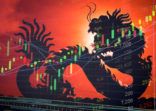Chinese equities rallied in 2017, with the MSCI China index gaining 54% during the year. However, Chinese banks lagged behind. In particular, the “big four”, the Bank of China (BOC), China Construction Bank (CCB), the Agricultural Bank of China (ABC), and the Industrial and Commercial Bank of China (ICBC), did not match the broad equity gains.
China Merchants Bank (CMB), which is controlled by state-owned China Merchants Group, surpassed them handily.
However, all the large mainland banks made a good showing in December 2017 and so far in 2018, rallying around 18%, and outpacing the equity index in January.
One-year price performance of China’s top six banks

Policy-driven rally?
ICBC’s Grace Zhou and Stella Liu, in a research note to clients, attribute the rally to a variety of factors, with the primary driver the “expectation of fundamental stabilisation”. Essentially, investors now have renewed faith in China’s efforts to reign in financial sector risk.
China’s regulator introduced measures in 2016 to reduce financial leverage, stem the growth of regulatory arbitrage, interbank financing and non-standard investment. All these measures had a negative impact on banks’ balance sheets. The impact of the regulations have now been priced in and are not expected to intensify, according to Zhou and Liu.
In fact, while smaller or provincial banks tend to be stressed by a tightening regulatory environment, China’s handful of big state banks, with huge resources and strategic state importance, have the advantage.
If pressure for financial deleveraging and the clamp-down on off-balance-sheet financing (shadow banking) work effectively, the expectation is that the big banks will be much more attractive investments.
Additionally, they generally have low valuations and pay high dividends.
Zhou and Liu also expect bank net interest margins to improve, thanks to increased interest rates. Fee income is expected to remain steady, as banks hike their credit card fees to offset decline in sales of wealth management products (new regulations make them less attractive as an interbank financing vehicle). The non-performing loans ratio, which peaked in early 2016, is likely to stabilise, even if the economy slows down, since the profitability of industrial SOEs has been improving.
Finally, China’s Belt and Road Initiative, a $1trn state-backed investment program spanning 68 countries, is also seen as a medium- and long-term boost to Chinese banks, which would be primary actors in financing of the multitude of projects and in managing the associated capital flows.
Funds and ETFs with highest exposure to Chinese banks
| Fund | Share of portfolio (%) | 1-year Return | |||||
| ICBC | CCB | ABC | BOC | CMB | 5 largest banks | (%) | |
| BMO Hong Kong Banks ETF | 12.7 | 20.6 | 4.14 | 14.8 | 4.7 | 57 | 39.5 |
| Ping An of China CSI Hong Kong Dividend ETF | 10 | 10.2 | 4.5 | 16.4 | 5.7 | 46.8 | 66.2 |
| Lyxor China Enterprise Ucits ETF | 10.3 | 10.4 | 3.3 | 9.9 | 3.9 | 41.6 | 38.5 |
| Hang Seng H Share Index Fund | 10.2 | 10.4 | 3.3 | 10 | 4 | 37.8 | 42.2 |
| SAM Value China ETF | 15.6 | 7.9 | 13.8 | 10 | 37.3 | 50.1 | |
| BEA Industry China Tracker | 10.4 | 9.6 | 3.3 | 9.6 | 3.7 | 36.6 | 37.7 |
| BEA China Tracker | 10.4 | 9.6 | 3.3 | 9.5 | 3.7 | 36.6 | 37.7 |
| Hang Seng/HSBC Value Choice HS H-Share Index Tracking Fund | 10.1 | 9.6 | 3.4 | 9.7 | 3.7 | 36.5 | 38.7 |
| BOCHK All Weather Hong Kong Equity | 9.6 | 9.7 | 13.1 | 32.4 | 52 | ||
| HS Financial Sector Flexipower | 8.7 | 8.53 | 13.2 | 30.4 | 40.4 | ||
















